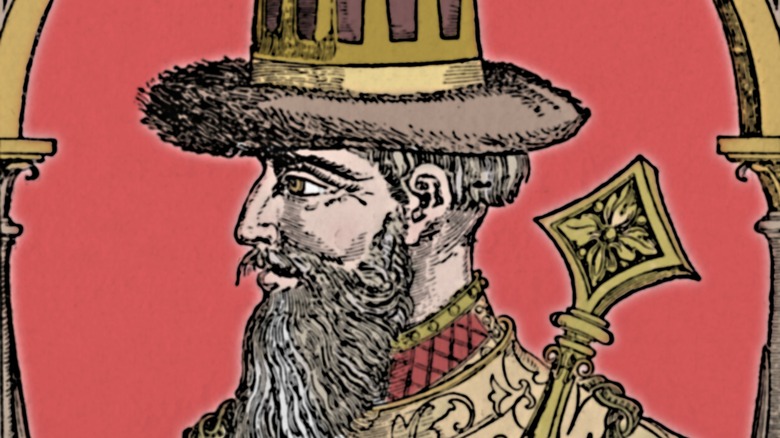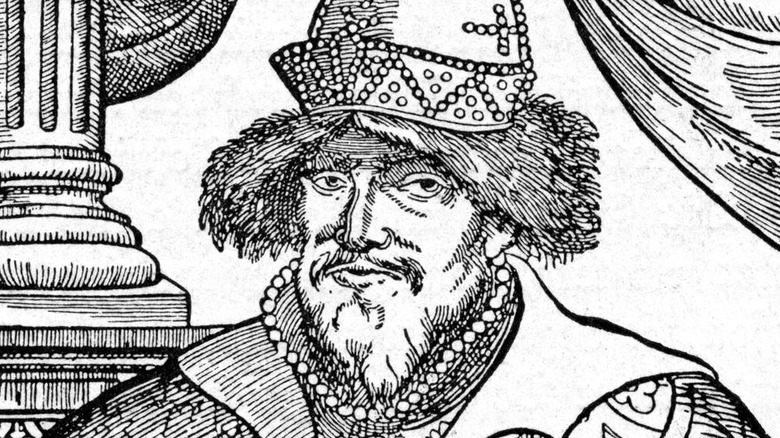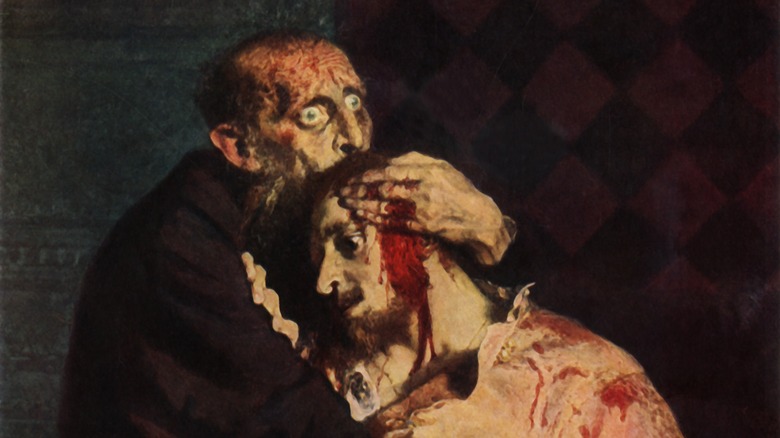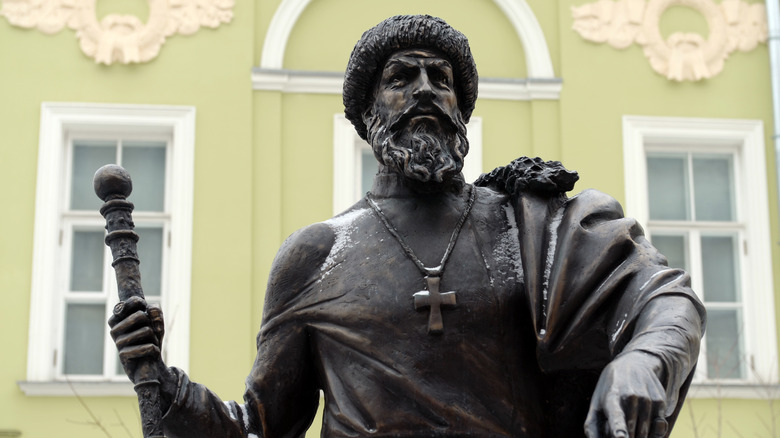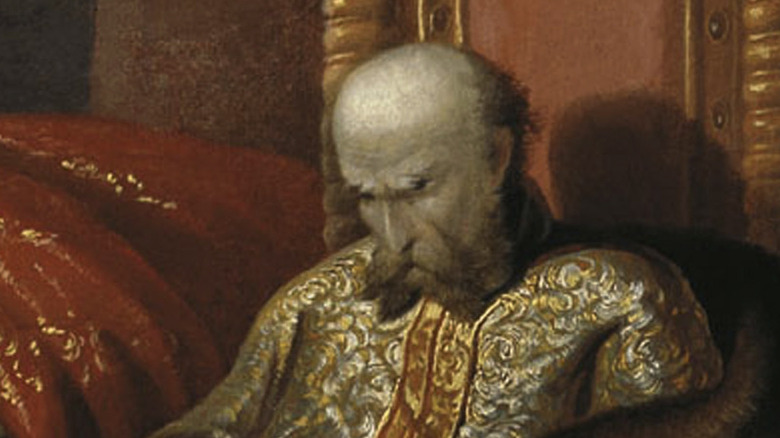How Ivan The Terrible Was Even More Evil Than You Think
Ivan the Terrible was Russia's first czar and Grand Prince of Moscow. He ruled the country from 1533 until his death in 1584. He was succeeded by his only living son, Fyodor I (via Britannica). Once upon a time, Ivan had three sons; one, Dmitry, died mysteriously at a young age long after his father's death, says Russia Beyond. But his oldest son and his namesake was killed by Ivan himself in 1581 (via On This Day).
In a case of uncontrolled rage, Ivan viciously attacked his son during a heated argument about the appropriateness of his daughter-in-law's clothing, which caused the younger Ivan to later die. The shocking incident was famously depicted in an 1885 painting (via The Art Newspaper). As his name suggested, and based on the act of killing his own child, Ivan the Terrible was obviously a very terrible person. But his cruelty extended beyond his family of course. His reign was a brutal one and will forever be remembered as a daunting time in Russian history. He had a hot temper, created a barbaric police force, and was responsible for killing many people.
Ivan the Terrible's formation of a death squad
Historians never miss the chance to recall how evil Ivan the Terrible was and the tools he used to extend his evilness. One of the most defining aspects of his reign was the creation of the oprichnina — a private police entity that orchestrated some of the most brutal crimes in 16th century Russia (via Russia Beyond). Members of the oprichnina were called oprichniki, and these men used fear, violence, and intimidation to subjugate people. Some even likened them to the KGB, per History of Yesterday. They committed a lot of wicked and immoral acts against innocent people and acted under the orders of the czar. So if Ivan had you in his eye and wanted you dead, the oprichniki would eventually be at your door. Through them, he ordered a lot of executions and sick torture.
The oprichnina was obviously something worth fearing, but it's the reason why the force existed in the first place that would explain the evil nature of Ivan the Terrible's character. He was not a trustful person and didn't like too many people — especially boyars, an elite class of Russians. It's a trait that stemmed from his abusive childhood and the subsequent paranoia he had. But he also wanted control to the point where he had the final say. And this is what led to the massacre of the Novgorod — a rival city to Moscow. His irrational paranoia led him to believe they were attempting to overthrow him and in 1570 he subsequently launched the first bloodiest massacre in Russian history, per History Collection.
Killing his own child
Taking someone's life is a grave crime, but taking the life of your child adds another layer of wickedness. The story of how he killed his son Ivan Ivanovich is recounted as a sudden fit of rage that the czar instantly regretted. Ilya Repin's famous painting "Ivan the Terrible and His Son Ivan," shows a distressed Ivan cradling his bleeding son in his arms. It's a telling image because it posits that he was aware of what he had done and had remorse.
A parent killing their child is not rare, but it remains one of the most bewildering and shocking crimes. Oftentimes, experts have said that a mother committing a crime against her child can be explained by her mental issues, such as postpartum depression, says The Atlantic. But what's the reasoning for a father doing the same? According to The Conversation, fathers, too, have mental episodes that can lead to acts of violence against their children, but there's another factor to it. Most people are not murderers but according to science, apparently, anyone with enough anger is quite capable of committing such an act, says Quartz.
When Ivan the Terrible ended up killing his own son because he riled himself up to that point, it was only confirmation that there was some kind of evil lurking within him. After masterminding a massacre, people probably could've seen this coming.
He had a lot of anger, coupled with the fact that experts say fathers who kill their children are more likely to have been abusive partners to their spouses, per The Conversation. Ivan the Terrible was married eight times, sending some of his former wives away to convents, and reportedly had some killed by drowning and poisoning (via Vintage News).
Unleashing brutal assaults on other relatives
But another glaring look into Ivan the Terrible's evil attitude was the incident with his daughter-in-law that evidently led to the fight where he took his son's life. According to Russia Beyond, on that day, the Czar expressed displeasure at an outfit his daughter-in-law, Yelena, was wearing. It wasn't "modest" enough for his liking. Rather than ignore or suggest a change of clothing, Ivan the Terrible got violent. He viciously beat and attacked her, and his son Ivan Ivanovich intervened. This led to a fight between father and son, and as the story goes, he hit his son on the head with a scepter and he fell to the ground. He died a few days later. But his son wasn't the only victim in the ordeal. His daughter-in-law endured an unprovoked beating, while she was pregnant, leading to the miscarriage of his grandchild (via Coda Story).
If Ivan the Terrible could kill innocents, use a ruthless police force to do his bidding, orchestrate the massacre of thousands, exile or kill some of his wives, and even beat his own daughter-in-law so badly that she miscarried — it's no wonder that the only other evil act left for him to commit was filicide.
Raised to be evil
It's common knowledge that a child's upbringing will affect their development and behavior later on in life. Children from abusive households and childhoods can have lifelong psychological issues that determine their personality, aggression, and attitudes, says Child Welfare. This was likely not common information back then, and when Ivan was left orphaned with his brother Yury, they had no close relatives to care for them. Instead, their care was left up to the boyars and other caretakers. And these people didn't shower them with love and care — his childhood was filled with neglect and controlling guardians, says Britannica.
His dislike of the mistreatment he received led to who he became. He had a disturbing relationship with animals and even tortured them, says Biography. Ivan had some sort of pleasure from it, and as it would turn out, as a ruler, he'd use oprichniki to also enact torturous punishments against his naysayers.
Experts have warned that children who take out their rage on animals could be prone to violence later on (via Discover Magazine), but it also means that they too are also the likely victims of abusive childhoods (BMJ). This was the unfortunate outcome for Ivan the Terrible.
